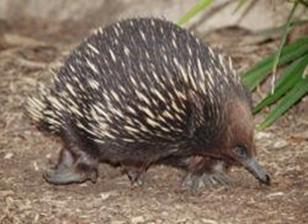


|
Monotremata:
Monotremes (monos, single + trema, hole; refers to the cloaca) are mammals that lay eggs instead of giving birth to live young like marsupials (Metatheria) and placental mammals (Eutheria). The subclass comprises a single order, Monotremata (though sometimes the subclass Prototheria is used). An infant monotreme is known as a puggle. General Characteristics:
Like other mammals, monotremes are warm-blooded with a high metabolic rate (though not as high as other mammals, see below); have hair on their bodies; produce milk to feed their young; have a single bone in their lower jaw; and have three middle ear bones. Monotremes were very poorly understood for many years, and to this day some of the 19th century myths that grew up around them endure. It is still sometimes thought, for example, that the monotremes are "inferior" or quasi-reptilian, and that they are a distant ancestor of the "superior" placental mammals. It now seems plain that modern monotremes are the survivors of an early branching of the mammal tree; a later branching is thought to have led to the marsupial and placental groups. Similarly, it is still sometimes said that monotremes have less developed internal temperature control mechanisms than other mammals, but more recent research shows that monotremes (such as the Platypus, which can maintain its body temperature even while living in an icy mountain stream) maintain a constant body temperature in a wide variety of circumstances without difficulty. Early researchers were misled by two factors: monotremes maintain a lower average temperature than most mammals (around 32°C / 90°F , compared to about 35°C / 95°F for marsupials, and 38°C / 100°F for most placentals); secondly, the Short-beaked Echidna (which is much easier to study than the reclusive Platypus) only maintains normal temperature when it is active: during cold weather, it conserves energy by "switching off" its temperature regulation. Physiology:
The key physiological difference between monotremes and other mammals is the one that gave them their name; Monotreme means 'single opening' in Greek, and comes from the fact that their urinary, defecatory, and reproductive systems all open into a single duct, the cloaca. This structure is very similar to the one found in reptiles. In contrast to the single cloaca of monotremes, other mammal females have separate openings for reproduction, urination and defecation: the vagina, the urethra, and the anus. Monotremes lay eggs. However, the egg is retained for some time within the mother, who actively provides the egg with nutrients. Monotremes also lactate, but have no defined nipples, excreting the milk from their mammary glands via openings in their skin. All species are long-lived, with low rates of reproduction and relatively prolonged parental care of infants. Living monotremes lack teeth as adults. Fossil forms and modern platypus young have the "tribosphenic" (three-cusped) molars, which are one of the hallmarks of mammals. However, recent work suggests that monotremes acquired this form of molar independently of placental mammals and marsupials (Luo et al, 2001). The jaw of monotremes is constructed somewhat differently from those of other mammals, and the jaw opening muscle is different. As in all true mammals, the tiny bones that conduct sound to the inner ear are fully incorporated into the skull, rather than lying in the jaw as in cynodonts and other pre-mammalian synapsids; however, this feature, too, is now claimed to have evolved independently in monotremes and therians (Rich et al, 2005). However, the external opening of the ear still lies at the base of the jaw. The monotremes also have extra bones in the shoulder girdle, including an interclavicle, which are not found in other mammals. Monotremes retain a reptile-like gait, with legs that are on the sides of rather than underneath the body. The monotreme leg bears a spur in the ankle region; the spur is non-functional in echidnas, but contains a powerful venom in the male platypus.
Their metabolic rate is remarkably low by mammalian standards, although the extent to which this is a characteristic of monotremes, as opposed to an adaptation on the part of the small number of surviving species to harsh environmental conditions, is uncertain.
Taxonomy:
The only surviving examples of monotremes are all indigenous to Australia and New Guinea, although there is evidence that they were once more widespread. Fossil and genetic evidence shows that the monotreme line diverged from other mammalian lines about 150 million years ago and that both the short-beaked and long-beaked echidna species are derived from a platypus-like ancestor. Fossils of a jaw fragment 110 million years old were found at Lightning Ridge, New South Wales. These fragments, from species Steropodon galmani, are the oldest known fossils of monotremes. Fossils from the genera Kollikodon, Teinolophos, and Obdurodon have also been discovered. In 1991, a fossil tooth of a 61-million-year-old platypus was found in southern Argentina (since named Monotrematum, though it is now considered to be an Obdurodon species). |
